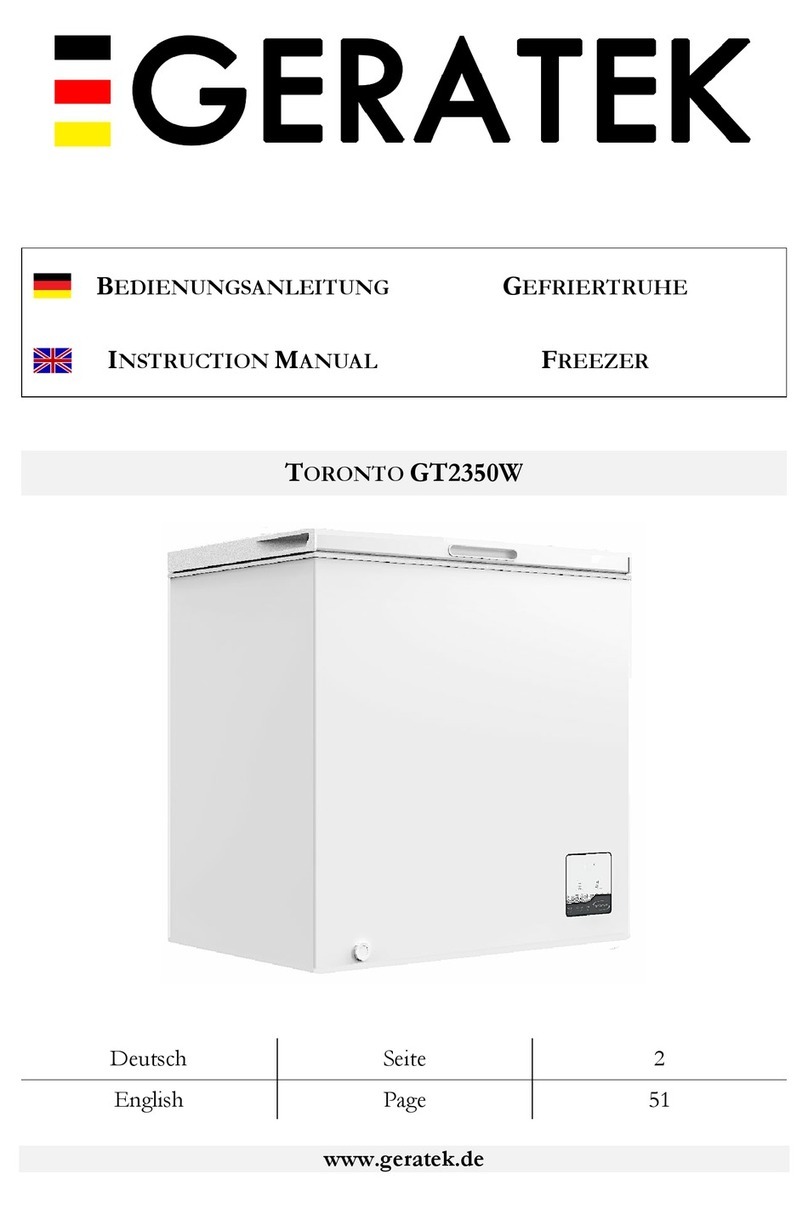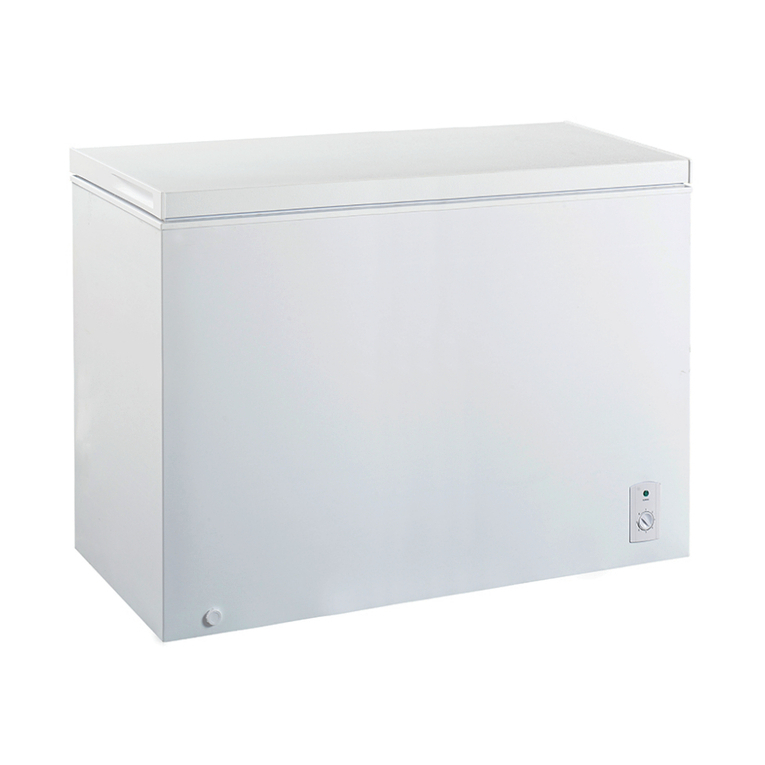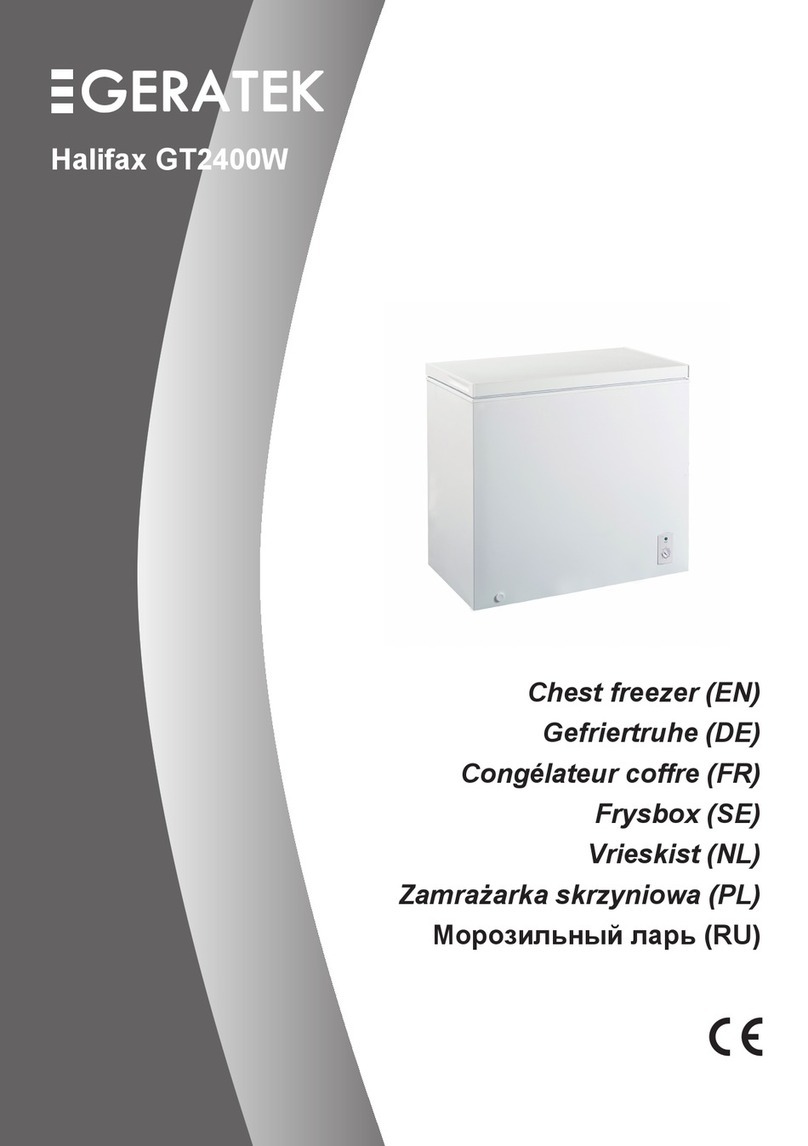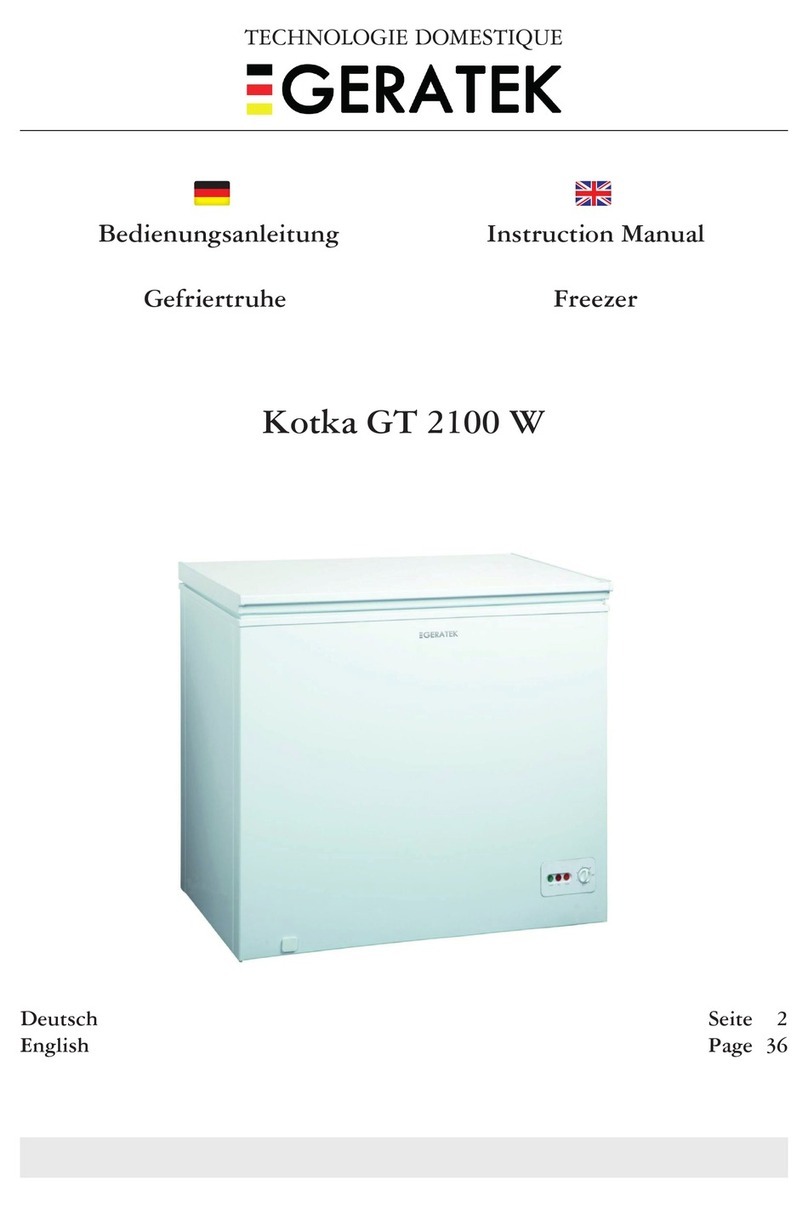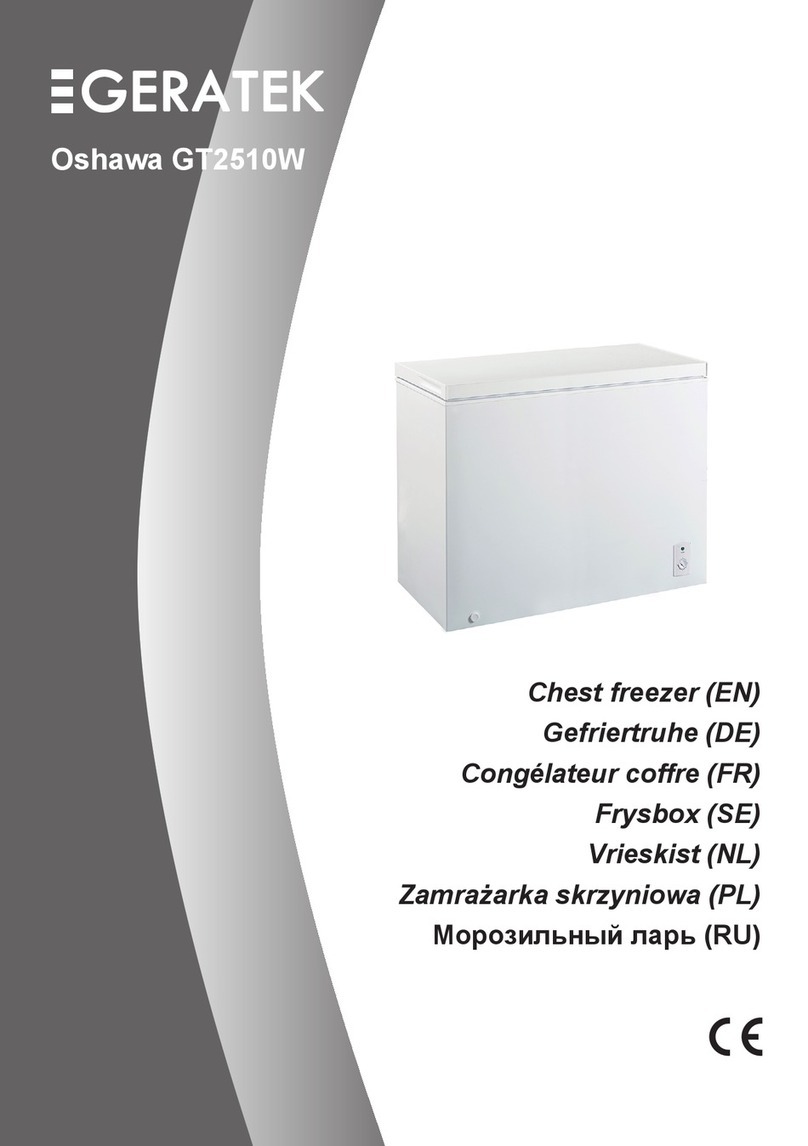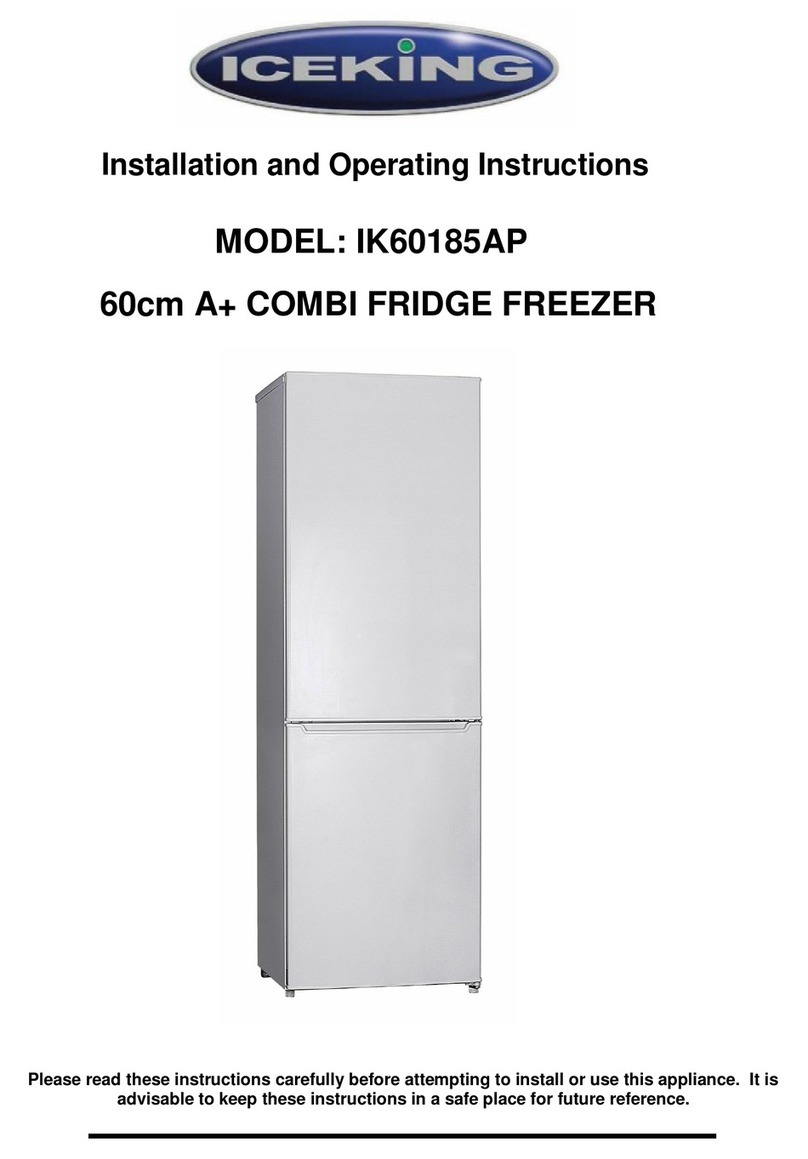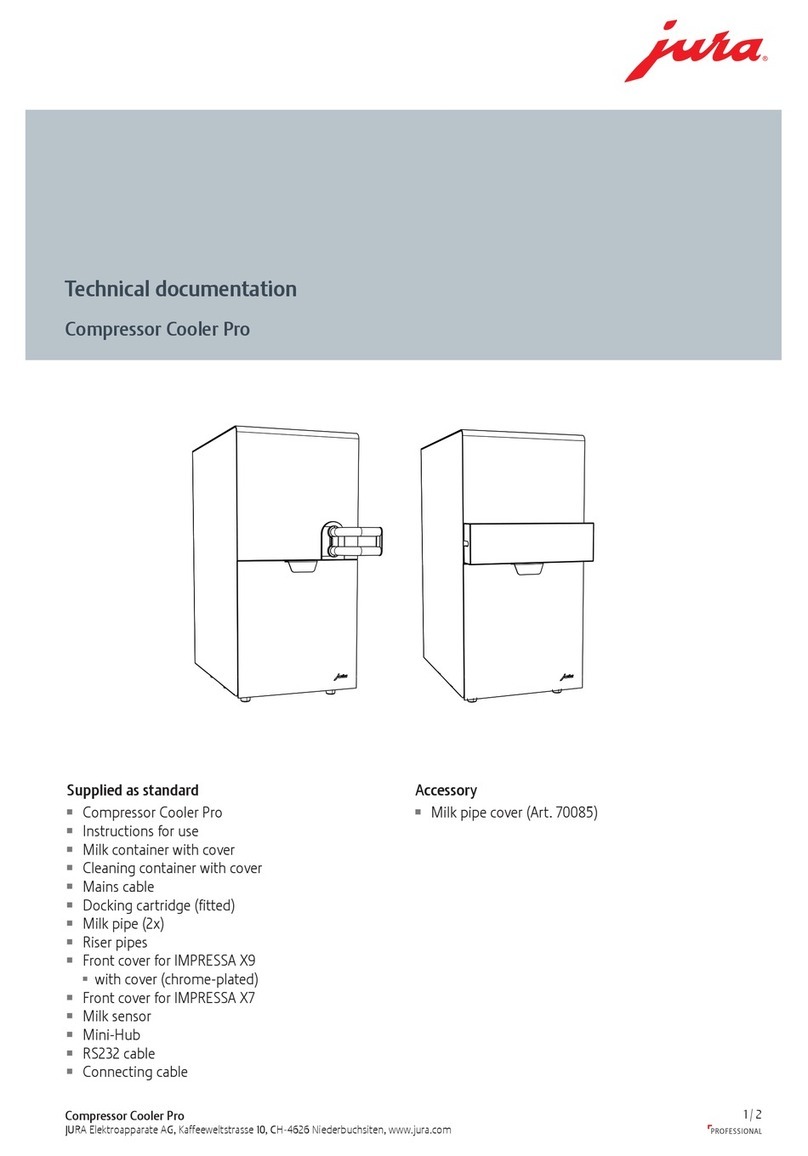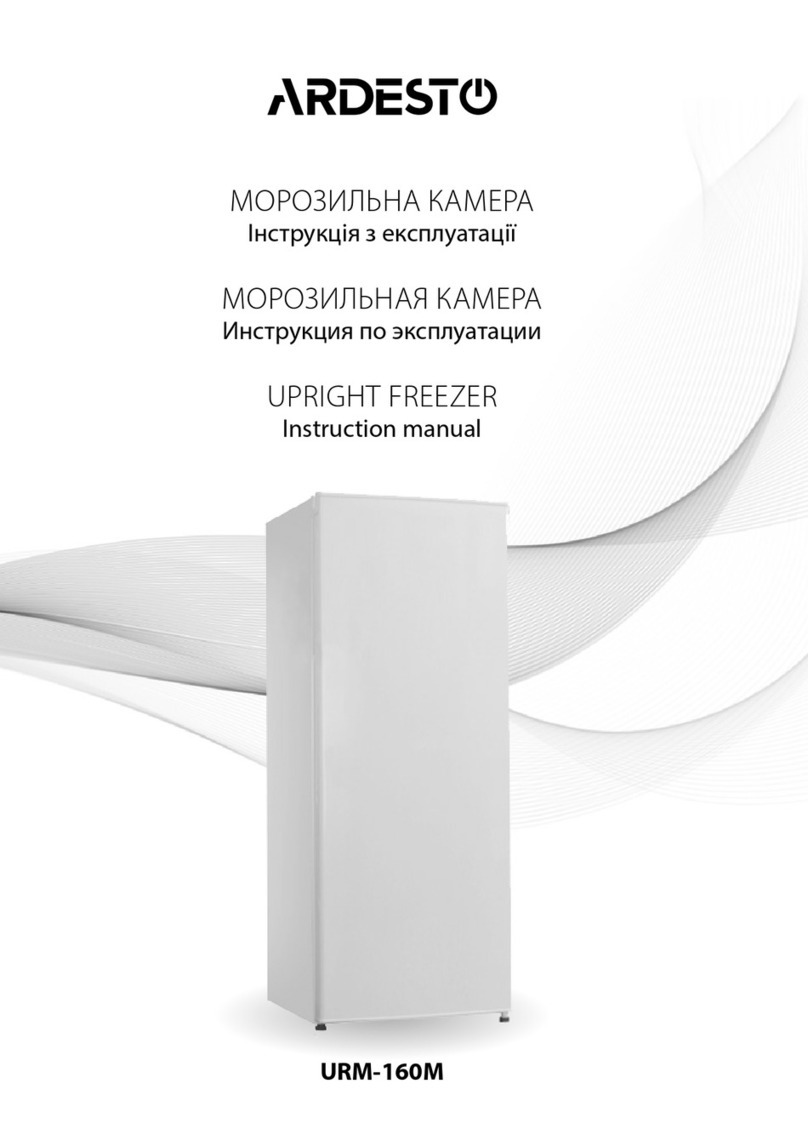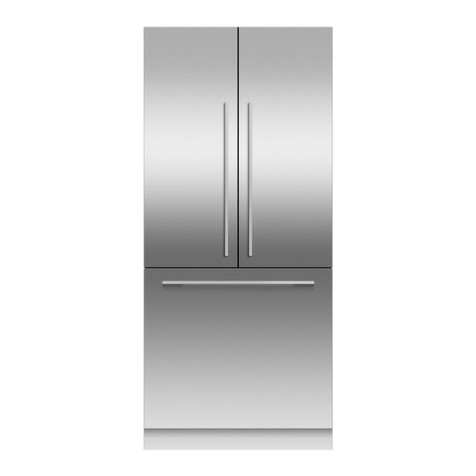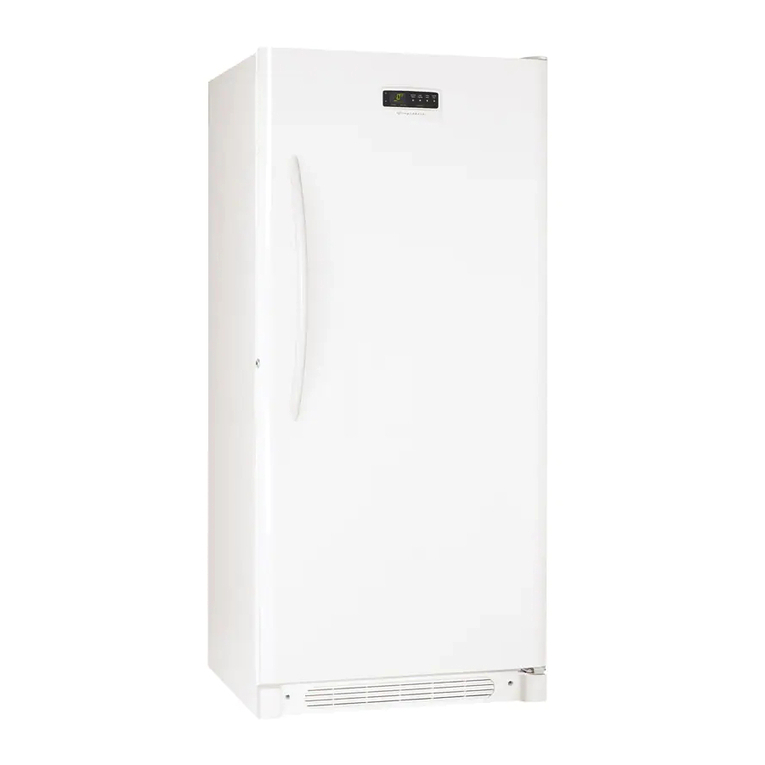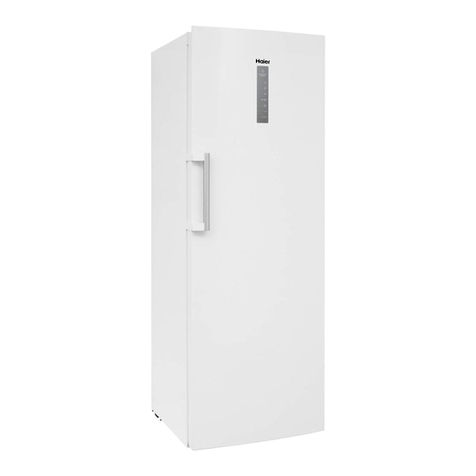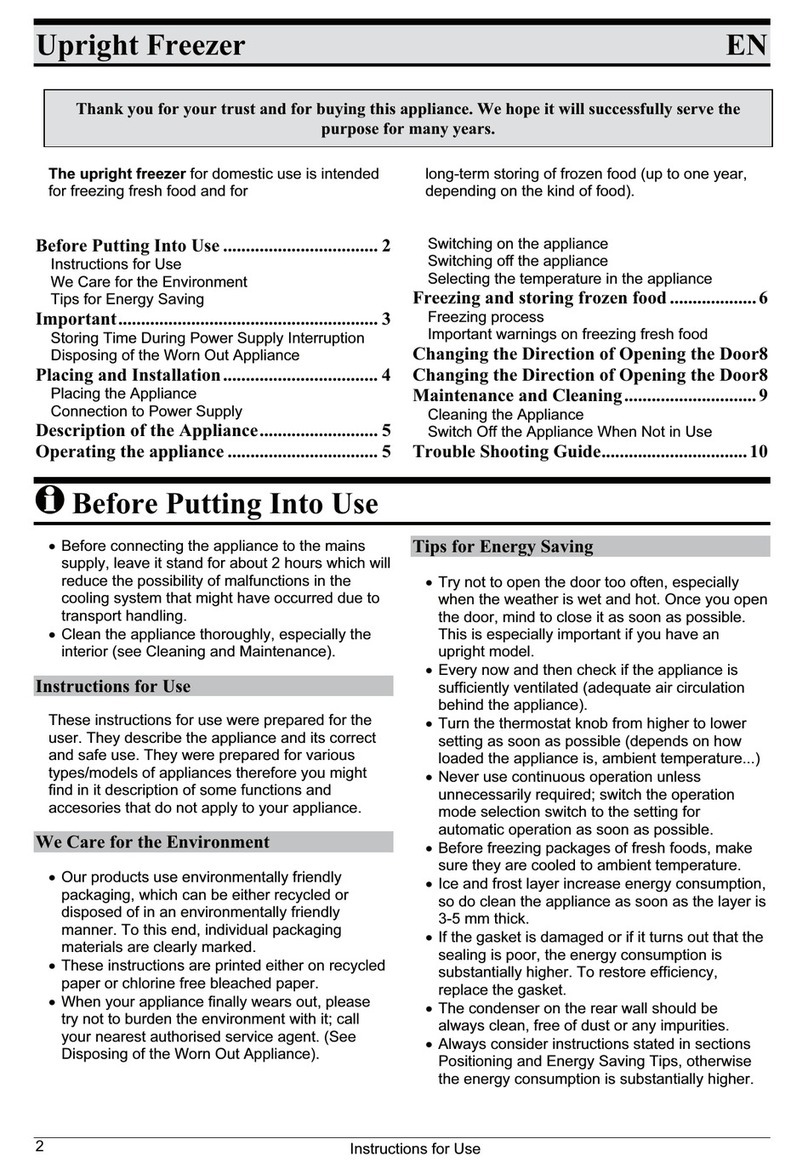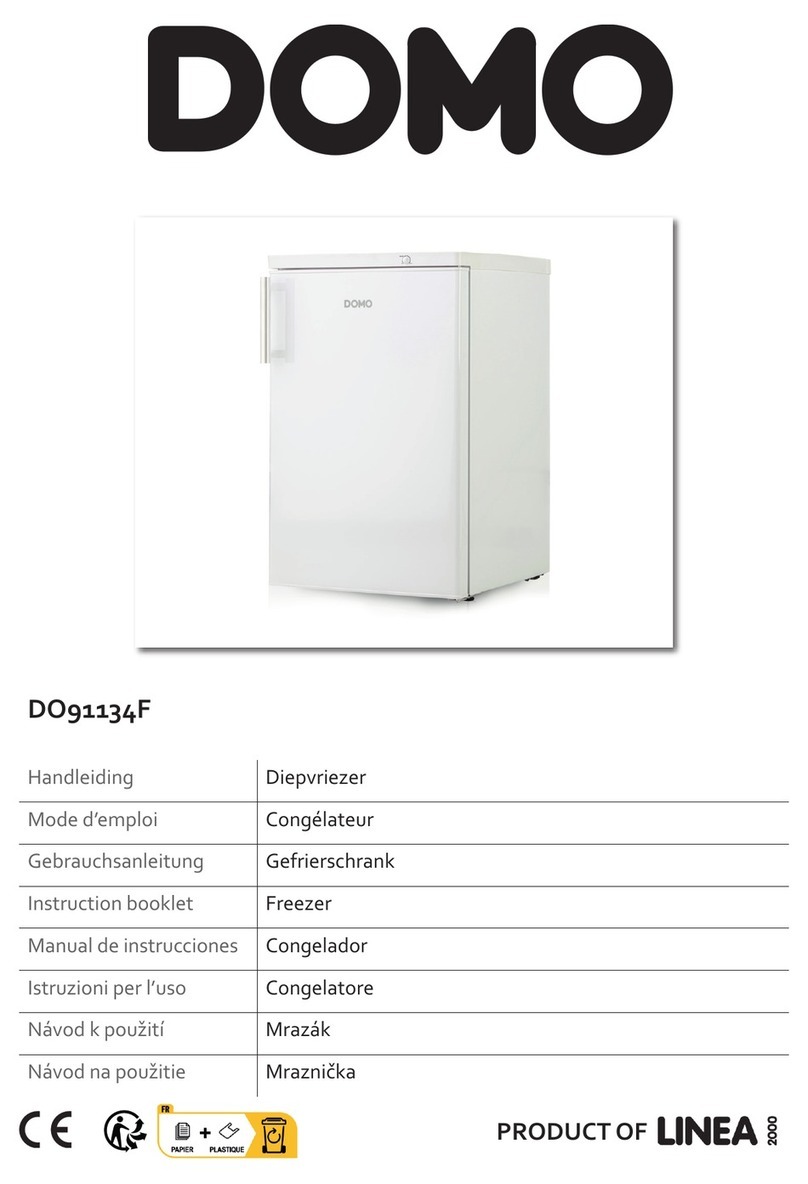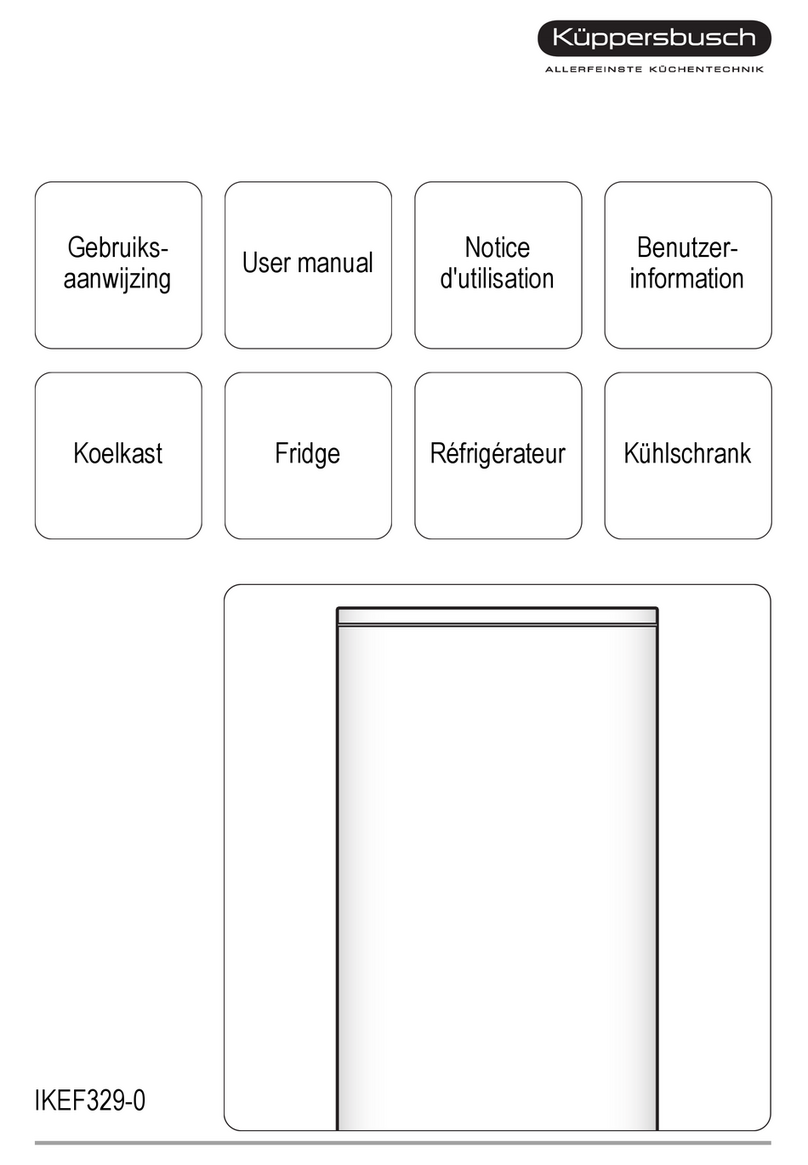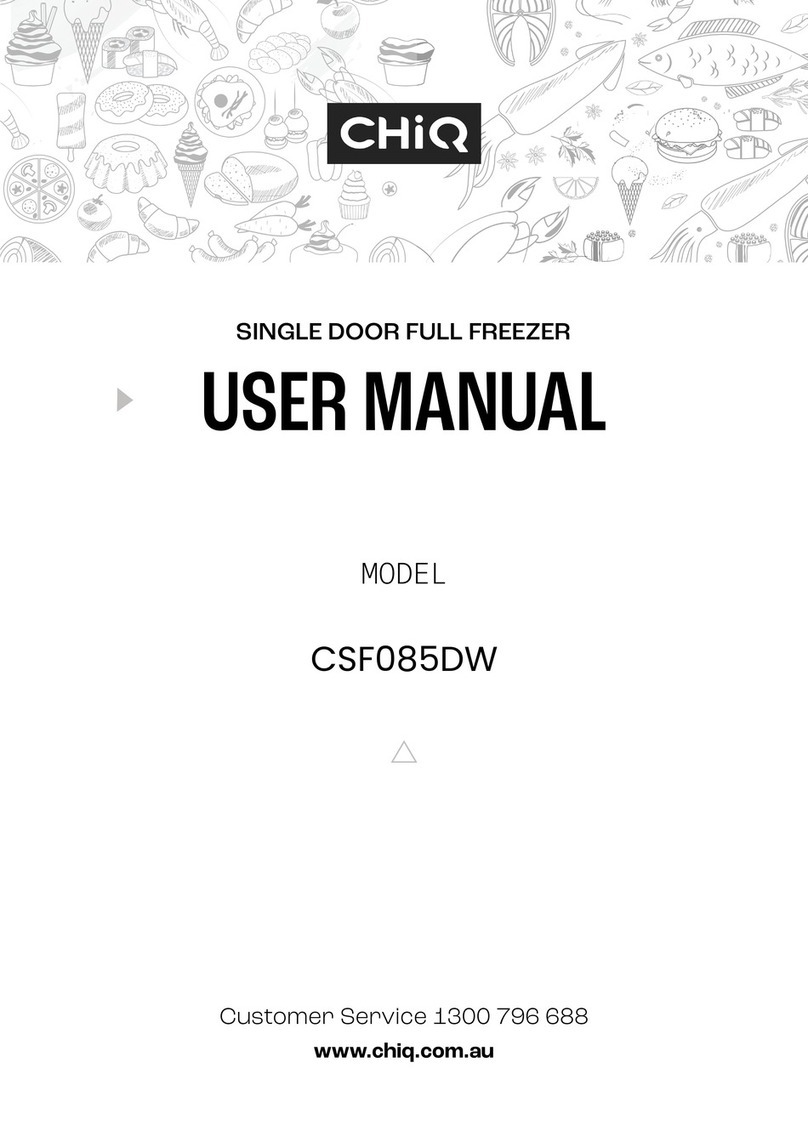GERATEK Turku GT3000W Specification sheet

Instructions for use and maintenance
CHEST FREEZER
FR-CF200DA+W
FR-CF250DA+W
FR-CF300DA+W
FR-CF400DA+W
Bedienungsanleitung
Instructions for use and maintenance
GEFRIERTRUHE
CHEST FREEZER
Espoo GT2500W
Turku GT3000W


DE-1
WICHTIGE SICHERHEITSHINWEISE
Hier finden Sie alle wichtigen Sicherheitshinweise. Lesen Sie sich alle Sicherheitshinweise
sorgfältig durch, bevor Sie das Gerät aufstellen und in Betrieb nehmen. Halten Sie sich
immer an die folgenden Anweisungen.
- Bewahren Sie die Bedienungsanleitung auf und geben Sie diese beim Verkauf des Geräts an den
Käufer weiter.
- Dieses Gerät darf nicht draußen aufgestellt werden, auch nicht unter einem Dach. Es bestehen große
Sicherheitsrisiken, wenn das Gerät Regen, Sturm oder schlechtem Wetter im allgemeinen ausgesetzt
ist.
- Berühren, benutzen oder bewegen Sie das Gerät niemals ohne Schuhe zu tragen oder mit nassen
Händen.
- Das Gerät ist ausschließlich auf die Nutzung im privaten Haushalt und zum Einfrieren von
Lebensmitteln ausgelegt.
- Achten Sie darauf, dass Verpackungsmaterial wie Plastikbeutel, Styropor und Plastikbänder immer
außerhalb der Reichweite von Kindern sind, da diese sich daran verletzten können.
- Erlauben Sie Kindern auf keinen Fall mit dem Gerät zu spielen (zum Beispiel das Sitzen im Korb oder
auf das Gerät zu klettern). Das Gerät kann kippen und Personen und Gegenstände in der Umgebung
beschädigen.
- Achten Sie beim Bewegen, Installieren und Reinigen des Geräts darauf, den Kühlmittelkreislauf auf
keinen Fall zu beschädigen.
- Achten Sie darauf, das keine elektrischen Geräte oder Komponenten (z.B. Ventilatoren, Schalter,
Steckdosen, etc.) in der Nähe der Lüfter installiert sind.
- Prüfen Sie nach dem Aufstellen des Geräts, dass es nicht auf dem Stromkabel steht.
- Wir empfehlen keine Verlängerungskabel oder Mehrfachsteckdosen zum Anschluss des Geräts zu
verwenden.
- Trennen Sie das Gerät zum Reinigen oder Warten stets vom Stromnetz oder nehmen Sie die
Hauptsicherung raus.
- Um das Gerät vom Strom zu trennen, ziehen Sie den Netzstecker. Ziehen Sie niemals am Kabel,
immer am Stecker.
- Jeder Korb hat eine Traglast von 15 kg. Bitte verteilen Sie das Gefriergut immer gleichmäßig.
- Geben Sie keine Flaschen oder andere Glasbehälter in die Gefriertruhe, diese können springen oder
zerbrechen, wenn der Inhalt gefriert.
- Wir empfehlen keine Lebensmittel zu verzehren, deren Haltbarkeitsdatum abgelaufen ist. Dies kann zu
einer Lebensmittelvergiftung führen.
- Stellen Sie nichts vor die Öffnungen und Lüftungen des Geräts.
- Vermeiden Sie Flammen und Funkenflug in der Nähe des Geräts.
- Verwenden Sie keine metallischen Hilfsmittel um den Abtauvorgang zu beschleunigen. Die
Missachtung dieses Hinweises kann zu irreparablen Beschädigungen des Kühlkreislaufs führen.
- Benutzen Sie keine elektronischen Geräte (Eismaschine, Geruchsneutralisierer, etc.) in der
Gefriertruhe.
Alle Wartungs- und Instandhaltungsarbeiten, inklusive eines Austauschs des
Stromkabels, müssen von einem Servicetechniker durchgeführt werden. Das
eigenständige Ausführen solcher Arbeiten kann zu schweren Verletzungen führen.
INSTALLATION
Um Beschädigungen von Gegenständen oder Personen zu vermeiden, sollte das Gerät immer
von zwei Personen installiert werden. Ist das Gerät während des Transport beschädigt worden,
informieren Sie Ihren Händler umgehend vor der Installation. Warten Sie nach dem Aufstellen
mindestens zwei Stunden, bevor Sie das Gerät in Betrieb nehmen, damit die Kühlflüssigkeit ihre

DE-2
(Abb. 1) 20 cm
9 cm
optimale Wirkung erzielt. Das Gerät muss in einer trockenen und gut gelüfteten Umgebung aufgestellt
werden und auf einem festen und geraden Untergrund stehen. Nutzen Sie die verstellbaren Füße um das
Gerät auszurichten. Zwischen der Geräterückseite und der Wand müssen mindestens 90 mm Abstand sein,
zwischen der rechten Seite des Geräts und der Wand müssen 200 mm Abstand eingehalten werden, um
eine ausreichende Luftzirkulation zu gewährleisten. (Abb. 1) Regale und Schränke oberhalb des Geräts
müssen mit einem Abstand von mindestens 80 mm befestigt sein. Da die Umgebungstemperatur die
Energieeffizienz beeinflusst, sollte das Gerät keiner direkten Sonneneinstrahlung ausgesetzt sein und
nicht direkt neben einem Heizkörper, Ofen, Heizlüfter, etc. aufgestellt werden. Prüfen Sie die
Klimaklasse auf dem Typenschild auf der Rückseite des Geräts.
WICHTIG:
Stellen Sie sicher, dass das Stromkabel jeder Zeit zugänglich ist, damit die Stromzufuhr wenn nötig
unterbrochen werden kann.
STROMANSCHLUSS
Das Gerät muss an eine ordnungsgemäß installierte Steckdose mit Sicherung angeschlossen werden. Die
Stromversorgung (AC) und Spannung am Betriebsstandort müssen mit den Angaben auf dem Typenschild
des Geräts übereinstimmen (das Typenschild befindet sichaufderRückseite des Geräts). Für Schäden, die
auf fehlende Erdung zurückzuführen sind, wird keine Haftung übernommen.
Austausch des Leuchtmittels (nur für Geräte mit Beleuchtung)
Nehmen Sie das Gerät vom Strom oder schalten Sie die Hauptsicherung ab, bevor Sie das Leuchtmittel
austauschen. Verwenden Sie nur Leuchtmittel mit der auf dem Lampen-Typenschild angegebenen
Wattleistung (Bspw. 15 W).
ERSTE SCHRITTE
Das Geräte für das Sie sich entschieden haben erlaubt Ihnen sowohl frische Lebensmittel einzufrieren
oder auch frische Lebensmittel zu kühlen (siehe Kapitel Gefrieren und Kühlen)
Einstellen der Temperatur (Abb. 2) Die Temperatur kann anhand des Thermostat in verschiedenen Stufen
eingestellt werden. Die Position “MIN” bedeutet, das Gerät arbeitet auf geringster Stufe. Die Position
“MAX” bedeutet, das Gerät arbeitet auf derhöchsten Stufe. Beachten Sie, dass die Temperatureinstellungen
von der Umgebungstemperatur, der Menge an gelagerten Lebensmitteln, der Positionierung des Geräts
und der Häufigkeit der Nutzung abhängt. Mit der Zeit werden Sie feststellen, welche Einstellung für Ihre
Situation passt.
Klimaklasse Umgebungstemperatur
SN Zwischen +10 und +32 (°C)
N Zwischen +16 und +32 (°C)
ST Zwischen +16 und +38 (°C)
T Zwischen +16 und +43 (°C)

DE-3
POWER
MIN
MAX
MIN
MAX
COMPRESSOR
F
R
E
E
Z
I
N
G
C
O
O
L
I
N
G
(C) -.NOsirosserpmoctahtsetacidni)ROSSERPMOC(DELneerg
You can keep frozen food for some months in the low temperature compartment (-18℃)under freezing
function, or you can adjust to keep fresh food in cooling compartment(0℃to 10℃) under feeling
function. We advise a thermostat setting in the middle position both for freezing and cooling. The
BCA
(Fig. 2).
POWER COMPRESSOR
(A) - Mit dem Thermostat steuern Sie die Temperatur im Gerät.
(B) - Rote LED (POWER) zeigt an, dass das Gerät am Strom angeschlossen ist.
(C) - Grüne LED (COMPRESSOR) zeigt an, dass das Gerät in Betrieb ist.
(Abb. 2).
Gefrorene Lebensmittel können mit der Gefrierfunktion (-18°C) bis zu mehreren Monaten im Gefrierteil
aufbewahrt werden, oder Sie bewahren frische Lebensmittel mit der Kühlfunktion bei 0 – 10°C auf. Wir
empfehlen sowohl für die Gefrier- als auch für die Kühlfunktion den Thermostat auf eine Mittlere Stufe
einzustellen.
Das Mindesthaltbarkeitsdatum finden Sie auf der jeweiligen Lebensmittelverpackung. Gefrorene
Lebensmittel die aufgetaut werden, dürfen auf keinen Fall erneut eingefroren und sollten so bald wie
möglich verzehrt werden.
Um Gerüche zu vermeiden und Lebensmittel frisch zuhalten,empfehlen wir ausschließlich verpackte
Lebensmittel in das Gerät zu geben.
WICHTIG: Geben Sie keine Glasbehälter mit warmer Flüssigkeit in das Gerät.
WICHTIG: Essen Sie keine Eiswürfel direkt aus der Gefriertruhe, diese können Gefrierbrand verursachen.
TIPPS ZUM EINFRIEREN
Achten Sie darauf, dass frische Lebensmittel nicht mit bereits gefrorenen in Kontakt kommen. Stellen Sie
sicher, dass die Lebensmittelverpackung trocken ist, damit die Produkte nicht mit anderen
zusammenfrieren.
Für ein schnelles Auftauen, sollten Sie Lebensmittel immer in kleinen Portionen einfrieren
- Um eine große Menge (>3kg) Lebensmittel einzufrieren, gehen Sie wie folgt vor:
- Drehen Sie das Thermostat 24 Stunden bevor Sie die Lebensmittel einfrieren wollen auf “MAX”
- Geben Sie frische Lebensmittel nie in die Körbe, diese dienen nur zur Aufbewahrung von Gefriergut
- Platzieren Sie die Lebensmittel mit der größten Fläche direkt an die Innenwand des Geräts und legen
Sie sie später in die Körbe
- Öffnen Sie die Gefriertruhe nur wenn unbedingt nötig und so kurz wie möglich
- 26 Stunden nachdem Sie mit dem Einfrieren begonnen haben, drehen Sie den Thermostat zurück auf
eine geringere Stufe
Kleinere Mengen Lebensmittel können ohne diese Vorgehensweise eingefroren werden, indem sie direkt
an die Innenwände des Geräts gelegt werden.

DE-4
ABTRAUEN DER GEFRIERTRUHE
Damit das Gerät effizient arbeiten kann empfehlen wir regelmäßig das überschüssige Eis (3-4 mm) von
der Innenseite und den Körben zu entfernen. Nutzen Sie niemals scharfe, spitze oder metallene
Gegenstände, Luftbefeuchter, Haartrockner oder Enteiser-Spray für diese Arbeit. Diese können irreparable
Schäden am Kühlkreislauf verursachen.
Wir empfehlen das Gerät dann abzutauen wenn es leer ist oder nur wenige Lebensmittel enthält. Für den
Abtauvorgang gehen sie wie folgt vor.
- Drehen Sie den Thermostat auf Stopp
- Ziehen Sie den Netzstecker oder nehmen Sie die Hauptsicherung heraus
- Halten Sie einen Schlauch und einen Auffangbehälter bereit, öffnen Sie de
n
Abfluss an der Vorderseite des Geräts (siehe Abbildung), verbinden Sie de
n
Schlauch mit der Abflussöffnung und legen sie die zweite Seite des Schlauch
s
in den Auffangbehälter, um das Wasser abfließen zu lassen
- Sobald sämtliches Eis geschmolzen ist, nehmen Sie das Wasser mit eine
m
Schwamm oder Tuch auf
- Reinigen und trocknen Sie die Innenwände.
- Stecken Sie das Stromkabel wieder ein und bringen Sie das Thermostat in di
e
gewünschte Position (siehe “Erste Schritte”).
WARTUNG UND REINIGUNG
Ziehen Sie den Netzstecker oder nehmen Sie die Hauptsicherung heraus bevor Sie beginnen. Zur
Reinigung der Innenseite des Geräts und der Körbe empfehlen wir Wasser und Essig (1 Löffel Essig in
2,5 L Wasser) Verwenden Sie auf keinen Fall Scheuermittel, Spülmittel oder Seife. Reinigen Sie die
Türdichtung mit Wasser und trocknen Sie sie sorgfältig ab.
Niemals einen Dampfreiniger zum Abtauen oder Reinigen des Geräts oder der Körbe verwenden.
Der Dampf kann spannungsführende Teile beschädigen und zu einem Kurzschluss und/oder
Stromschlag führen. Zudem können Plastikteile beschädigt werden.
LÄNGERE NCHTNUTZUNG
Sollten Sie das Gerät für einen längeren Zeitraum nicht nutzen, ziehen Sie den Netzstecker, leeren und
reinigen Sie das Gerät und lassen Sie den Deckel offen (um Schimmel und unangenehme Gerüche zu
vermeiden).
FEHLER UND MÖGLICHE URSACHEN
Die Temperatur ist nicht niedrig genug.
Prüfen Sie ob:
- Der Deckel der Truhe ordnungsgemäß geschlossen ist
- Das Thermostat in der richtigen Position ist
- Das Gerät nicht in der Nähe einer Heizquelle steht
- Das Gerät nicht direkt an der Wand steht und die Luft zirkulieren kann
- Das sich kein Eis auf den Kühlstäben gebildet hat
Die Temperatur im Gerät ist zu niedrig.
Prüfen Sie ob:
- Das Thermostat in der richtigen Position ist
- Die “Super” Taste deaktiviert ist (nicht bei allen Modellen vorhanden)
Das Gerät ist zu laut.
Prüfen Sie ob:
-Das Gerät vollständig gerade steht
- Platz zwischen der Rückseite und der Wand ist (mind. 90 mm hinten, 200 mm rechts).
Das Gerät funktioniert nicht

DE-5
Prüfen Sie ob:
- Das Thermostat nicht auf “Stopp” steht
- Die Sicherung eingelegt ist
- Der Stecker ordentlich in der Steckdose sitzt
- Das Stromkabel nicht beschädigt ist (siehe Kapitel WICHTIGE SICHERHEITSHINWEISE)
Sollten Sie alle oben beschriebenen Punkte geprüft haben und das Gerät funktioniert weiterhin nicht,
wenden Sie sich bitte an den Kundendienst (siehe beiliegende Garantiekarte)
WICHTIG:
Die Gefriertruhe kann folgende Geräusche verursachen:
Wird die Gefriertruhe in einem feuchten, unbeheizten Raum aufgestellt, kann sich Kondenswasser an der
Außenseite entwickeln. Besonders dann, wenn die Umgebungstemperatur niedrig und die Luftfeuchtigkeit
hoch ist. Dies beeinträchtigt die effiziente Arbeitsweise oder Lebensdauer des Geräts nicht.
Der Hersteller übernimmt keine Haftung für Schäden an Personen, Haustieren oder Gegenständen, die auf
eine unsachgemäße Handhabung zurückzuführen sind und sich mit dem Lesen dieser
Gebrauchsanweisung hätten verhindern lassen. Speziell die Hinweise zu Reinigung und Wartung.
UMWELT UND ENTSORGUNG
Dieses Gerät erfüllt alle Anforderungen der Europäischen Richtlinie 2002/96/CE im
Bezug auf die Entsorgung von Elektroschrott (WEEE).Wir bestätigen, dass unsere
Produkte die Anforderungen der anzuwendenden Europäischen Verordnungen,
Richtlinien und Entscheidungen sowie der aufgeführten Nomen erfüllen.
Das Gerät muss bei der entsprechenden Sammelstelle abgegeben werden, sodass elektrische und
elektronische Teile der Weiterverwertung zugeführt werden können. Durch die ordnungsgemäße
Entsorgung von Altgeräten leisten Sie einen wertvollen Beitrag zum Schutz von Umwelt und Gesundheit.
Ausführliche Informationen zum Entsorgen des Geräts erhalten Sie beim zuständigen
Abfallwirtschaftsamt, beim Abfallentsorgungsunternehmen oder beim Händler, bei dem Sie das Gerät
gekauft haben.
Entsorgen Sie das Verpackungsmaterial nicht im Hausmüll, sortieren Sie es nach den Materialgruppen
(z.B. Styropor, Pappe, Plastik, etc.) und entsorgen Sie es den lokalen Richtlinien entsprechend. Dieses
Gerät enthält keine FCKW (der Kühlkreislauf enthält R600a- Isobutane)
R600a (ISOBUTANE)
Isobutan ist ein natürliches Gas das keine negative Umwelteinflüsse hat, aber leicht entflammbar
ist. Deshalb ist es zwingend notwendig vor der Installation zu prüfen, ob der Kühlkreislauf
unbeschädigt ist. Achten Sie darauf, dass der Raum in dem das Gerät aufgestellt wird groß genug ist. Je 8
Gramm der Kühlflüssigkeit, ist 1 Kubikmeter Raum nötig. Stellen Sie sicher, dass im Falle eines
Gasaustritts keine offenen Flammen oder anderen Zünder in der Nähe sind.


EN-1
IMPORTANT SAFETY WARNINGS
This section contains the main safety warnings. Read them carefully
before installing and using the equipment and always follow the instructions in them.
- Always keep the instruction manual and, if you sell the equipment, hand it over to the new owner.
- This appliance must not be installed outdoors, not even if under a roof; it’s extremely dangerous to
leave it exposed to rain, storms and bad weather in general.
- Never touch, operate or move the appliance with bare feet or wet hands or feet.
- The equipment must be used exclusively for the domestic preservation and/or freezing of food.
- Packaging materials such as plastic bags, polystyrene and plastic tapes must be kept out of reach of
children as they are potential sources of danger.
- Don’t allow children to play with the appliance (for example by sitting in the baskets or climbing on
the hatch), as this may cause it to tip over or cause objects on top of the freezer to fall off.
- Be careful not to damage the cooling fluid circuit during positioning, installation or cleaning.
- Make sure that no electrical appliances or components (eg. fans, switches, power outlets, etc.) are in
stalled near the air vents
- Having installed the equipment, make sure it’s not resting on the power cable.
- We advise against using extensions or multiple plugs to connect to the mains supply.
- Before carrying out any cleaning or maintenance operations, disconnect the equipment at the power
outlet or switch off your entire power system.
- To disconnect the equipment from the mains supply, remove the plug but don’t do this by pulling the
cable.
- Each basket can take a distributed load of 15 kg.
- Don’t put bottles or other glass containers in the low temperature compartment and they may crack or
break when their contents are frozen.
- Don’t eat food whose eat-by date has expired, as this may lead to food poisoning.
- Don’t obstruct any of the opening/vents in the appliance.
- Avoid flames or sparks inside the appliance.
- During defrosting, never use metallic objects to accelerate the process. Failure to observe this rule
could cause irreparable damage to the cooling fluid circuit.
- Don’t use electrical appliances (ice-cream makers, deodorizers, etc.) inside the equipment.
All maintenance operations, including replacement of the power cable, must be carried
out by our customer service engineers. Failure to do so may entail the risk of serious
danger for the user.
I
NSTALLATION
T
he equipment must be installed by tw
o
p
eople in order to avoid damage to person
s
and things. If the equipment has suffered damag
e
during transport, immediately inform the supplie
r
before connecting up. Wait at least two hours afte
r
installation before putting the appliance into operation
,
to allow the cooling fluid to reach optimum efficiency
.
The equip- ment must be put in a dry, well ventilate
d
place. It must be installed on a flat, stable surface
.
Adjust the levelling feet if necessary. There must be a
t
least 90mm space between the back of the equipmen
t
and the wall, at least 200mm space between the wal
l
and the right side of the cabinet for better ai
r
9 cm
20 cm
(Fig. 1).

EN-2
ventilation(Fig. 1). Any shelving or cupboards over the appliance must be at least 800 mm from the
cover. Ambient temperature con- siderably affects energy consumption, so the equipment shouldn’t be
exposed to direct sunlight or placed next to heat sources such as heaters, stoves, cookers, etc. Check the
climate classification on technical data plate on the back of the equipment.
''SN '' (operates at ambient temperatures between) +10° C and +32° C
''N'' (operates at ambient temperatures between) +16° C and +32° C
''ST '' (operates at ambient temperatures between) +16° C and +38° C
''T'' (operates at ambient temperatures between) +16° C and +43° C
Important:
Make sure there is easy access to the power outlet so that the plug can be removed when necessary. If
this isn’t possible, connect the equipment to the mains by means of a bipolar switch, in an accessible
position, with a contact opening of at least 3 mm.
ELECTRICALCONNECTION
Connection of the equipment to a power outlet with an earth contact is a legal requirement. For this
reason the equipment is fitted with a plug with an earth wire for connection to an outlet of the same
type. The manufacturer declines any liability for damage to persons, property or pets due to failure
to observe this rule. Check that the voltage indicated on the technical data plate on the back of the
equipment is the same as that of your mains supply.
How to replace the lamp (only for appliances with lamp) Unplug the equipment or switch off at the main
power switch before replacing the lamp. Only use lamps of the wattage indicated on the lamp shield
(eg. max. 15 W).
GETTING TO KNOW YOUR FREEZER
The freezer you’ve chosen allows you to store both frozen,to freeze fresh food and cooling the fresh
food(see the section on freezing and cooling). Temperature regulation (Fig. 2) The temperature can be
regulated in steps by means of the thermostat. Position ''MIN'' means equipment operation at minimum
mode.Position ''MAX'' means equipment operation at maximum. Remember that thermostat settings are
affected by variation in ambient temperature, the quantity of food stored, the position the equipment is in
and how often the door is opened. Experience will tell you which setting is right for your needs.
(A) - thermostat regulates the temperature inside the appliance.
(B) - red LED (POWER) indicates that the equipment is powered on by the mains.
(C) - green LED (COMPRESSOR ) indicates that compressor is ON.
(Fig. 2).
POWER
MIN
MAX
MIN
MAX
COMPRESSOR
F
R
E
E
Z
I
N
G
C
O
O
L
I
N
G
(A) - thermostat regulates the temperature inside the appliance.
(B) - red LED (POWER) indicates that the equipment is powered on by the mains.
(C) -.NOsirosserpmoctahtsetacidni)ROSSERPMOC(DELneerg
BCA
(Fig. 2).
POWER COMPRESSOR

EN-3
You can keep frozen food for some months in the low temperature compartment (-18℃) under freezing
function, or you can adjust to keep fresh food in cooling compartment(0 ℃to 10 ℃) under cooling
function. We advise a thermostat setting in the middle position both for freezing and cooling. The torage
deadline for foods is usually written on the packaging. Under freezing function if a product that starts to
defrost must under no circumstances be re-frozen and must be consumed as soon as possible. And if
want to keep cooling for certain fresh food, do remember to adjust the knob to cooling function. To
preserve flavours, consistemcy and freshness we suggest wrapping food in aluminium or cling foil and
placing it in containers with a lid.
Important: do not put glass containers with warm liquid in them in the low temperature compartment.
Important: don’t eat ice cubes or lollypops straight out of the freezer, as they make cause ice burns.
TIPS ON FREEZING
Prevent products to be frozen coming into contact with products that are already frozen. Make sure
packets are dry, as this will prevent them from freezing together in a solid block.
- Always prepare food in individual portions, which are quicker to thaw out.
- To freeze the maximum quantity of food indicated on the technical data plate, proceed as follows:
- Set the thermostat to position ''7'' 24 hours before freezing.
- Never freeze food in the baskets as they are only suitable for storage.
- For fast freezing, arrange the packaged food with the biggest surface areas in contact with the inside
walls and then transfer to the storage baskets when freezing is complete. Only open the freezer when
necessary and even then as briefly as possible.
- 26 hours after the start of freezing put the thermostat back to the energy saving setting.
- Small quantities of food (up to 3 kg) may be frozen by placing them directly against the walls of the
freezer.
DEFROSTING THE FREEZER
To save energy, we recommend routine removal of excess frost (3-4 mm) from the inside of the equip-
ment and the cooling grids. Never use sharp or pointed objects or metal tools, humidifiers or heaters,
hairdryers or anti-freeze sprays to do this job. They could irreparably damage the cooling circuit and be a
source of danger in equipment with R600a. We advise defrosting when the compartment is empty or only
containing a few items of food.
To defrost, proceed as follows:
- turn the thermostat switch to stop;
- take the plug out of the wall outlet or switch off the mains system;
- prepare a pipe and basin, open the plug in the front of freezer, connect pip
e
to drainage hole and put the other side of pipe to basin to drain off water;
- when all the frost has melted, take up the water with a sponge or cloth;
- clean and dry the walls;
- put the plug back in at the wall outlet and set the thermostat as desired (se
e
the “Getting to know your freezer” section.
MAINTENANCEAND CLEANING
Remove the plug from the wall outlet before proceeding or disconnect the general power switch. To clean
the inside of the equipment and its fittings we suggest using water and vinegar (1 spoon for every
2.5 l water). Never use abrasives, detergent or soap. Clean the door sealings with water and dry carefully.
Never use a steam cleaner to defrost or clean the equipment. Steam can damage live parts in the
equipment and produce a short-circuit and/or electric shock. Steam also damages plastic parts.

EN-4
PROLONGED DISUSE
If you go away for long periods, disconnect the equipment from the mains supply, empty, clean the in-
side and leave the door open (to prevent mould and bad odours forming).
DRAWBACKS AND REMEDIES
The inside temperature isn’t low enough.
Check that:
- the door is perfectly closed; the thermostat is in the correct position;
- the freezer is not near a heat source;
- the freezer is not installed against the wall and that there is free circulation of air;
- there isn’t excess frost on the cooling grids.
The inside temperature is too low.
Check that:
- the thermostat is in the correct position;
- the super switch is off.
The appliance is too noisy
Check that:
- the equipment is level;
- the rear element isn’t touching the back wall;
The equipment isn’t working at all.
Check that:
- the thermostat isn’t set at stop;
- the power supply isn’t off;
- the plug is properly in the wall outlet;
- the power cable isn’t broken (see the section headed IMPORTANT SAFETY WARNINGS). If the
freezer still won’t work properly after carrying out the procedures described above, call the nearest
CUSTOMER SERVICE (indicated on attached slip).
Important: the freezer may produce the following slight noises:
When the freezer is installed in a damp, unheated area, droplets of condensation may form on the external
surfaces, especially with relatively low ambient temperatures and high relative humidity. This phenom-
enon in no way affects the equipment’s efficiency or life cycle.
The manufacturer declines any liability for damage that may directly or indirectly be caused to
persons, property or domestic animals by failure to observe all the indications in the instruction
booklet, and especially the warnings regarding installation, use and maintenance.
The manufacturer also reserves the right to make any modifications deemed technically or commercially
appropriate at any time and under no obligation to give prior notice.

EN-5
E
NVIRONMENTAL INFORMATION
T
his appliance is marked in compliance with European Directive 2002/96/C
E
r
egarding dis- posal of waste electrical and electronic appliances (WEEA). Th
e
i
con of a rubbish bin with a cross over it on the appliance means that th
e
appliance must not be treated as ordinary domes-
tic waste on reaching the end of its useful life but must be taken to the appropriate collectio
n
centres for electrical and electronic waste or handed over to a retailer when buying a new on
e
of a similar type. Dif-
ferentiated collection of this appliance helps avoid negative impact on the environment and people ’ s
health as a re- sult of incorrect treatment of the product.
Disposal must be carried out in compliance with current local environmental regulations.
For more detailed information on treatment, disposal and recycling of this product, contact your local
waste disposal service or the retailer where you bought it.
Don’t throw the packaging material from your equipment in the rubbish but sort the various materials (eg.
polystyrene, cardboard, plastic bags, etc.) as required by local regulations.
This appliance does not contain CFCs (the cooling circuit contains R600a - ISOBUTANE).
R600a (ISOBUTANE)
Isobutane is a natural gas that doesn’t affect the environment, but it is inflammable. Before con-
necting the equipment to the mains, it is therefore indispensable to check that the cooling circuit
tubing is not damaged. For every 8 grams of cooling fluid, there must be a minimum of 1 cubic metre of
space in the room where the appliance is installed. In the event of a leakage of cooling fluid, make sure
that no flames or other sources of ignition are allowed to get near the leakage point.



This manual suits for next models
1
Table of contents
Languages:
Other GERATEK Freezer manuals
